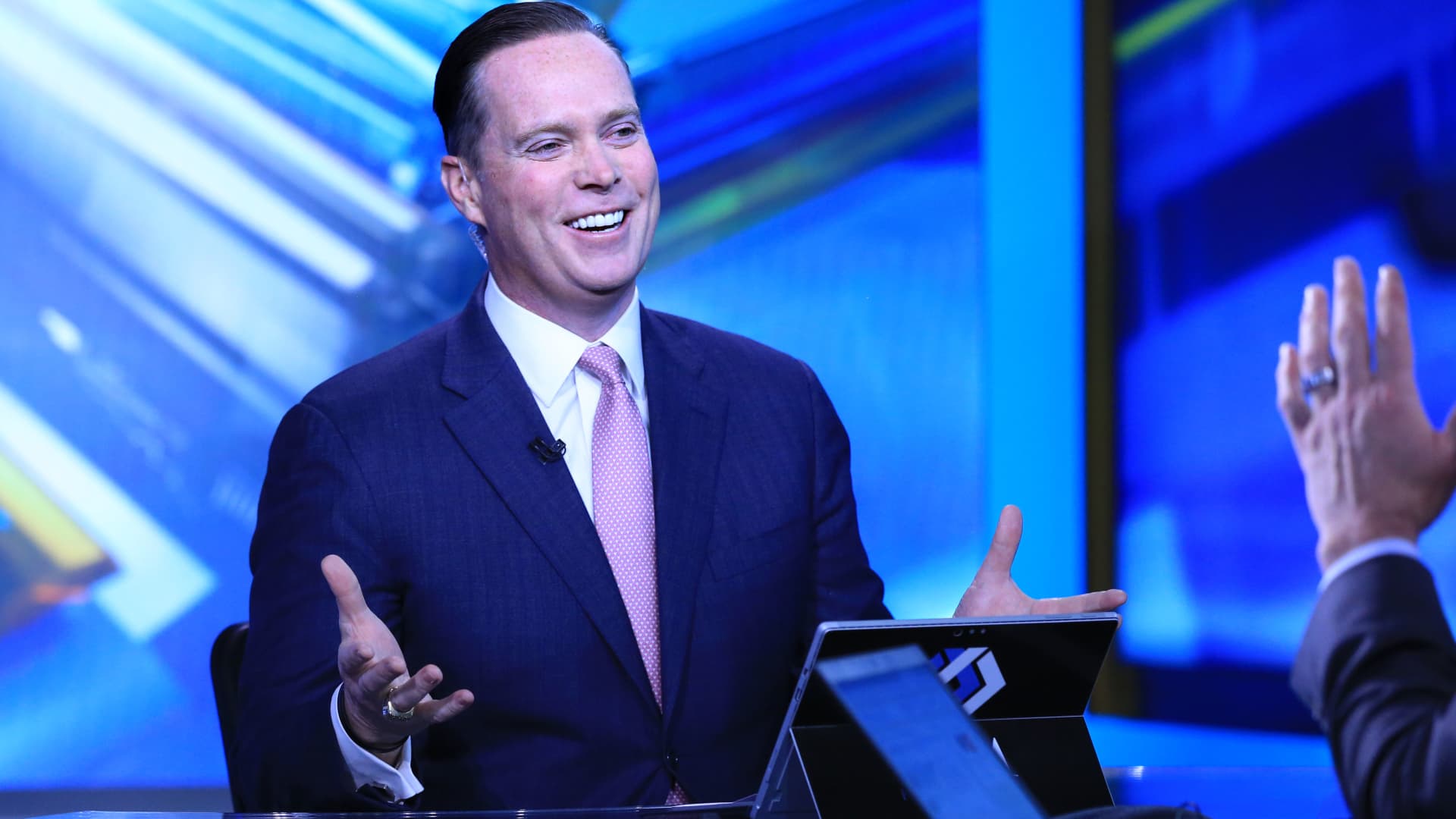- Navigating National Security Risks in AI-Related Investments FTI Consulting
- A recap of the Trump Administration’s approach to regulating artificial intelligence A&O Shearman
- White House AI Action Plan Addresses Ethical and Regulatory Challenges in Pharmaceutical Integration geneonline.com
- White House AI Action Plan: What Healthcare Leaders Must Do Now MedCity News
- A look at the White House’s pro-innovation artificial intelligence ‘action plan’ Reason Foundation
Category: 3. Business
-
Navigating National Security Risks in AI-Related Investments – FTI Consulting
-
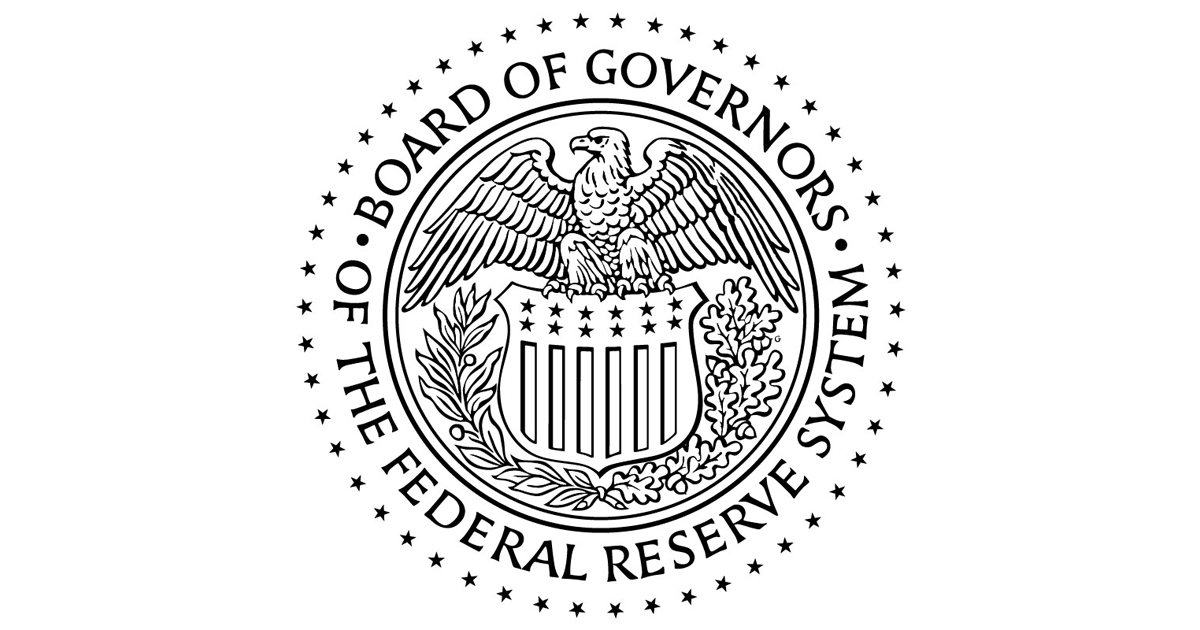
Speech by Governor Barr on community development and Indian Country
Good afternoon. Thank you for the invitation to be here to help mark the 10th anniversary of the Center for Indian Country Development (CICD) and to further the goal of advancing development through better data.1 It’s a privilege to be in the presence of so many tribal leaders, Federal Reserve colleagues, policymakers, researchers, and practitioners all working to advance Native economies. My experiences traveling with CICD and engaging in CICD’s work have been a meaningful part of my time at the Federal Reserve.
At the Board of Governors, I serve as the oversight governor for our Division of Consumer and Community Affairs, which supports the community development function across the Federal Reserve System. It’s a role that means a great deal to me. Community development has been a cornerstone of my career—as a governor, banking regulator, and earlier in my career as a scholar, university leader, and the Treasury Department’s point person on community development in the 1990s.
I’d like to focus my remarks today on why I think the work you all are doing is critical to the prosperity of Native nations and Indigenous communities, and why that success matters for our country.
Two years ago, I traveled to western Montana with CICD staff. We visited the Blackfeet Indian Reservation, which is home to the Blackfeet Nation, and the Flathead Indian Reservation, which is home to the Confederated Salish and Kootenai Tribes.
On our visit, I saw examples of tribal leaders diversifying their economies through tribally owned enterprises—and then leveraging revenues from those enterprises to reinvest in their communities. I heard from business leaders struggling with supply chain challenges and community members pulling together to address housing supply and affordability issues.2 At a community roundtable, financial leaders talked about credit needs in their regions including challenges with limited credit and access to financial services and distance from banks.
These issues take center stage in CICD’s research. And in our conversations, research served as a springboard for a variety of community members and leaders to come together to explore solutions. This is why community engagement is a critical part of community development, and a huge value add for the Federal Reserve as we seek to understand how people are experiencing the economy.
I see this same spirit of working together on behalf of a better future—grounded in research—on display here today.
Economic Gaps and Data Needs in Indian Country
There remain persistent economic gaps in Indian Country based on many metrics. Native Americans have lower household income, and poverty is a significant problem on reservations.3 According to the Federal Reserve’s Survey of Household Economics and Decisionmaking (SHED Survey), Native American households consistently report a lower likelihood of having the cash to pay for a $400 emergency expense, which is a common measure of financial security.4 Looking at the labor force, unemployment is higher for Native American workers than for workers overall. Research has also documented a lack of financial institutions near reservations, which restricts capital and credit availability. A recent study showed that Native-owned small businesses were less likely to receive the financing they applied for, even though they were much more likely to apply for small amounts of credit.5 Native Americans also face a higher cost of homeownership.Economic downturns can exacerbate gaps, such as when social-distancing measures during the COVID-19 pandemic disproportionately harmed sectors such as gaming and entertainment in which many tribally owned businesses are concentrated.
Addressing these persistent challenges requires coordination with local leaders to achieve progress. During my first stint at the Treasury in the 1990s, I co-chaired a working group whose objective was to reduce barriers to mortgage lenders and expand access to credit in Indian Country, with pilot programs in the Navajo Nation and Oglala Sioux Pine Ridge Reservation. The working group helped map out a clearer process for residents to obtain mortgages by coordinating tribal governmental, federal, and lender roles.6 I see this as an example of potential progress that can be made when national and local leaders and the private sector leverage research and come together to find solutions, but also as a reminder that these are long-standing problems that are still with us today.
In other ways, tribal governments have been proactive in diversifying their revenue streams and innovating in their use of economic data to make evidence-based decisions. Native Community Development Financial Institutions (CDFIs) are addressing credit gaps in their communities with culturally informed lending practices and financial services. There are many examples of initiatives targeting specific economic challenges. We see signs of progress, including positive trends in Native American employment and household income. But we’ll only know whether we’re making economic gains in Indian Country over time if we have timely, high-quality data disaggregated for Native peoples and geographies. Data dashboards are not just for researchers. They help tribal nations and decisionmakers in many capacities make informed decisions about how to allocate resources, design interventions, and monitor economic growth.
We know that Indian Country has sometimes been referred to as the “asterisk nation” as a result of insufficient sample sizes of Native Americans in national datasets. Experiences in which external researchers used data in ways that were harmful to tribal communities have also contributed to mistrust of research and data in Indian Country. At the same time, many tribal governments have limited resources to allocate toward their own data collection.
Research and Data Advancements
Research and data advancements in Indian Country are changing this narrative. Over the past decade, CICD’s research has advanced our understanding of the pillars of tribal economies and potential interventions.7 We’ve learned more about the role of tribal governments and tribal enterprises in local and regional economies, and the ways tribal treasuries are distinctive from those of local and state governments. CICD’s research has helped us understand how infrastructure gaps such as broadband access can impede economic growth and leave communities more vulnerable to economic shocks. And it’s provided research insights on strategies for increasing access to capital and credit in Native communities.Much of this research has taken place in collaboration with Native organizations, tribal governments, and economic development practitioners. In some of these areas, such as research on the practices and outcomes of Native CDFIs, CICD and its collaborators have provided some of the first systematic quantitative analysis in the field.
CICD has also developed a suite of data tools that empower community members and decisionmakers to explore economic conditions at local to national levels and monitor trends over time.
Indian Country’s Relevance to the Broader Economy
This work to advance economic research and data in Indian Country matters to the overall economy. The Federal Reserve promotes a healthy economy and a stable financial system for everyone, and that simply cannot be done without supporting strong and sustainable communities in Indian Country. Research tells us that Native economies are closely intertwined with local and regional economies. Examples include tribal casinos attracting visitors to surrounding businesses and Native enterprises subcontracting with non-Native-owned businesses.CICD’s mission supports the Federal Reserve’s community development function, which works to promote access to credit, investment, and financial services in low- and moderate-income communities, and foster a better understanding of their economic conditions. This happens in a few ways.
As members of the Federal Open Market Committee, my colleagues and I decide on the appropriate setting for monetary policy. In this role, it’s vital that we understand how a variety of individuals, institutions, and communities experience the economy. Research from CICD and community development teams here in Minneapolis and across the Federal Reserve System sheds light on economic circumstances in our communities.
As important as it is, monetary policy isn’t the main thing that matters to a healthy economy. Businesses, financial practitioners, nonprofits, community leaders, and decisionmakers at many levels all need research and data to make evidence-based decisions and promote thriving and economically resilient communities. The community development function provides this research and convening power to advance our collective understanding of local financial needs.
Our community development work also provides timely, on-the-ground insights on developments in the financial system. A prime example of this is the series of surveys CICD conducted during the COVID-19 pandemic. These surveys provided real-time glimpses of the challenges that tribal governments, businesses, and community leaders were facing as a result of the pandemic.
In addition, under the Community Reinvestment Act, the Federal Reserve has a statutory obligation to supervise how banks meet the credit needs of the communities they serve, consistent with safe and sound lending practices. And that very much includes communities in Indian Country. And we need good data and analysis to fulfill our statutory obligations.
What it comes down to is that the Federal Reserve does our best work when we understand what’s happening in communities, and that includes the rich variety of communities across Indian Country.
Learning from Indian Country
As we look to the future, decisionmakers inside and outside of Indian Country can learn from the ways tribal governments have served their communities and guided their economies through many challenges. In my visits with tribal leaders, I have been inspired by their long-range vision—considering how decisions today will affect their ability to care for their communities for generations into the future.I’ve also come to appreciate their grit and creativity in meeting community needs, whether it be through starting a tribal bank to meet local financial service needs, leveraging tribal enterprises to create employment opportunities, or innovating in their use of economic data to tailor public services to their communities.
Much has been said about the economic challenges in Indian Country, but perhaps what has impressed me the most in my visits is the sense of optimism for the future from so many people I have met, despite these challenges.
Thank you for the important ways you are coming together to use research and data to propel your communities forward. It’s an honor to be here with you.
1. The views expressed here are my own and are not necessarily those of my colleagues on the Federal Reserve Board or the Federal Open Market Committee. Return to text
2. See the Federal Reserve of Minneapolis website at https://www.minneapolisfed.org/speeches/2021/us-senate-testimony-housing-for-native-americans-review-of-federal-programs-barriers-and-opportunities and https://www.minneapolisfed.org/article/2024/native-americans-pay-more-to-finance-home-purchases-than-white-borrowers. Return to text
3. Federal Reserve Bank of Minneapolis, Native Community Data Profiles. Return to text
4. Board of Governors of the Federal Reserve System, Economic Well-Being of U.S. Households in 2024 (Washington: Board of Governors, May 2025). Return to text
5. See the Federal Reserve of Minneapolis website at https://www.minneapolisfed.org/article/2024/native-entrepreneurs-face-credit-access-challenges. Return to text
6. U.S. Department of Housing and Urban Development and U.S. Department of the Treasury, One-Stop Mortgage Center Initiative in Indian Country: A Report to the President (PDF) (Washington, DC: HUD, 1999). Return to text
7. Casey Lozar, Caryn Mohr, and Ryan Nunn, “Insights from a Decade of Economic Research in Indian Country,” article (Federal Reserve Bank of Minneapolis: April 3, 2025). Return to text
Continue Reading
-

Briefing Note:Key Tax Measures from Budget 2027 | Publications | Insights & Events
Main Takeaway
Budget 2027 maintains a fiscally prudent stance with no
broad personal income tax rate cuts, while enhancing
targeted supports for households, business investment
incentives, housing supply and climate action.The below provides a brief overview of the more relevant
changes that may be of interest to corporate entities followed
by a table providing a general overview of the more significant
tax changes brought in by Budget 2027, across all taxes.Corporate Tax, Research and Development
(R&D) and Capital MarketsMeasures aimed at the corporate sector strategically
reinforce Ireland’s reputation as an innovative base, providing
enhanced incentives for research and supporting capital
market participation for indigenous enterprises.Impact on Corporate Taxpayers
A central component of the budget’s innovation strategy is
the substantial enhancement of the R&D tax credit. The rate
is being increased from 30% to 35%. This enhancement
provides significant encouragement for both multinational
corporations (MNCs) and indigenous companies to base their
high-value innovation activities in Ireland.Furthermore, the measure includes vital liquidity and
compliance improvements for smaller claimants.The first-year
payment minimum threshold is being raised from €75,000
to €87,500. This adjustment directly enhances cash flow for
Small and Medium Enterprises (SMEs) engaged in R&D,
accelerating their access to state funding.Implications for Investors and Investment
FundsIn the financial services sector, stability and technical clarity
are prioritised. The exit tax rate applied to payments made
from Irish funds and equivalent offshore funds to Irish
individual investors has been reduced from 41% to 38%. This
adjustment aims to improve retail participation in investment
funds, as it enhances net returns for non-resident and
domestic investors.Combined with the unchanged 9% value-added tax (VAT) on
property-related services, Ireland’s fund ecosystem retains
competitive cost structures.In support of capital markets, a new market cap exemption
threshold of €1 billion is introduced for Irish SMEs and startups
trading on regulated markets. For companies falling below
this threshold, the standard 1% stamp duty charge paid on
share transactions will no longer apply. The SME marketcap
threshold stamp duty exemption is aimed at attracting
increased equity financing for growth companies listed on
regulated markets, bolstering liquidity and investor appetite.Entrepreneurial Incentives and Capital
GainsTo stimulate entrepreneurial activity and reward risk-takers,
the Capital Gains Tax (CGT) Revised Entrepreneur Relief has
been significantly strengthened. The overall lifetime limit on
gains eligible for the reduced 10% CGT rate is increased
from €1 million to €1.5 million. This 50% increase applies to
qualifying disposals made on or after 1 January 2026. This
policy signals a strong commitment to supporting successful
founders and incentivises them to reinvest their capital within
the Irish economy, thereby promoting further start-up creation
and economic dynamism.In support of capital markets, a new market cap exemption
threshold of €1 billion is introduced for Irish SMEs and startups
trading on regulated markets. For companies falling below
this threshold, the standard 1% stamp duty charge paid on
share transactions will no longer apply.This measure is positioned as essential for enhancing the
growth prospects of homegrown businesses, particularly
those seeking to secure funding or scale internationally. The
Key Employee Engagement Programme (KEEP) has also been
extended until the end of 2028.Conclusion
Although from a personal income tax perspective Budget
2027 has a much more targeted and measured approach
to what we’ve seen in previous years, the enhancements
to R&D incentives, fund taxation and SME reliefs should
hopefully lower effective tax burdens for corporates and
investors, foster greater deal activity in growth sectors
and prop up Ireland’s positioning as a tax-efficient hub for
innovation finance.The below table provides a brief summary of the pertinent
tax changes brought in by Budget 2027. We now wait for
the publication of Finance Bill 2026, to see exactly how
these measures will be implemented.Tax Area Measure Key Change/Rate Effective Date (or Period) Potential Impact / Client Action Corporate & SME Tax Directly or indirectly, individually or in aggregate Treated as if itself on the Entity List Same restrictions as parent entity apply Same restrictions as parent entity apply Unlisted foreign entity owned ≥ 50% by MEU List party Directly or indirectly, individually or in aggregate Treated as if itself is an MEU Same restrictions as parent
MEU entity applyUnlisted foreign entity owned ≥ 50% by an SDN* Directly or indirectly, individually or in aggregate Treated as if itself an SDN* Same restrictions as the SDN owner Financial Services Exit Tax (Investment Funds) Reduced rate on fund payments to individuals 41% to 38% Aims to encourage greater retail participation by Irish individuals in
domestic investment funds.SME/Start-up Stamp Duty Exemption New Market Cap Threshold in respect of shares traded on regulated markets. Up to €1 billion (Exemption applies) Supports capital market liquidity and growth for indigenous SMEs and start-ups. Indirect Taxes (VAT & Excise) VAT on Hospitality/Hairdressing Reduced rate introduced 13.5% to 9% (from 1 July 2026) Significant support for the services sector, aiding more than 150,000 jobs facing cost pressures. VAT on Gas and Electricity Reduced rate extension 9% extended until 31 Dec 2030 Provides long-term certainty and relief on essential energy costs for households and businesses. Carbon Tax (Auto-Fuels) Increased rate per tonne of CO2 €63.50 to €71.00 (from 8 Oct 2025) Immediate increase in the cost of petrol and diesel; future cost increases for home heating fuels (May 2026). Tobacco Excise Duty Increase per packet of 20 cigarettes +50 cent (from 7 Oct 2025) Will push the cost of a popular packet of 20 cigarettes towards €19. Housing Supply & Development VAT on New Apartments Reduced sales rate 13.5% to 9% Direct reduction in construction costs, intended to lower the final price of new apartment units. Derelict Property Tax (DPT) New tax to replace Derelict Sites Levy Rate not < 7%=”” of=”” market=”” value=”” (implementation=”” /> Allows Revenue to enforce a minimum 7% annual charge on the market value of vacant land. Employment & Global Mobility SARP Minimum Income Threshold Increased threshold €125,000 (from 2026) Requires review of all current/planned expatriate assignments;
employees below €125k will cease to qualify for the relief.Foreign Earnings Deduction (FED) Increased maximum relief; Scope widened €50,000 (from 2026) and now includes Philippines & Turkey Improves competitiveness for deploying employees to/from expanded market list (Philippines, Turkey). Company Car BIK Relief (€10k OMV reduction) Relief Tapering Schedule €10,000 (2026); €5,000 (2027); €2,500 (2028); Abolished (2029) Requires immediate review of corporate fleet policies due to rapid BIK relief withdrawal starting in 2027. Personal Tax (Income & USC) USC 2% Rate Band Ceiling Increased by €1,318 (to €28,700) 1 January 2026 Provides marginal tax relief for middle-income earners; protects minimum wage earners from moving into the top USC rate band. Rent Tax Credit Extended (Value remains €1,000 p.a.) Extended to end of 2028 Confirms continued cost-of-living support for eligible tenants for three additional years. Mortgage Interest Relief Extended (reduced value in final year) Extended for 2 years (2025 and 2026) Provides temporary support for homeowners but note the relief value diminishes in 2026. Continue Reading
-

The Best Anti-Prime Day Deals for Amazon Haters (2025): Sheets, Sex Tech, and Fire Pits
The waning hours of Amazon Prime Day—or Prime Big Deal Days—are the star of the show right now, but maybe you want to go shopping somewhere else. Whatever your reasoning, fear not! Plenty of other stores, big and small, are hosting sales alongside Amazon through the end of today. Everything below is hand-tested by WIRED, and doesn’t have to be bought on Amazon. You do you.
If you want to take a gander at the rest of our Amazon Prime Day coverage, updated through the end of the event tonight at 11:59 am ET, you can find it all right here.
Updated October 8, 2025: We’ve added new deals from Slumber Cloud and The Company Store.
WIRED Featured Deals:
Cozy Earth: Up to 25 Percent Off Sitewide—Use Code WIRED
Ask almost anyone on the WIRED Reviews team about their opinion on Cozy Earth, and it’ll be positive. The company makes supremely soft, silky, and comfortable bamboo products, ranging from bedding and linens to pajamas and hoodies. The Cozy Days sale means you can save up to 25 percent off nearly everything on the website.
Backcountry 70 Percent Off Flash Sale
Backcountry is offering up to 70 percent off select outdoor gear and apparel. The sale includes biking, skiing, and climbing gear.
Best Buy’s Techtober Sale
Want some great deals on tech gear but are avoiding Jeff Bezos? Best Buy might not be much better, spiritually, but the retailer is offering a few deals during its Techtober sale that we haven’t seen elsewhere. Techtober lasts until Sunday.
Bookshop.org Anti-Prime Sale: Free Shipping
It’s easy to buy books from big-box stores, but Bookshop.org helps support authors and local bookstores. Right now, you can get free shipping on all orders during its Anti-Prime Sale. You can check out popular books here, or might I recommend Everything Is Tuberculosis by John Green? (I just started it and I had to force myself to put it down until the weekend.)
Solo Stove Two-Day Sale
Solo Stove makes a lot of solid gear, including pizza ovens and its well-known fire pits. Right now, nearly everything is on sale, and it’s a great time to pick something up ahead of the colder and cozier months.
Chirp Wheel XR (3-pack) for $104 ($26 off)
The Chirp Wheel XR helped our tester Hannah Singleton with her tech neck woes. You’ll get multiple different sizes with the three- or four-pack, which are specially designed to help work out kinks and tension in various points of your body. It’s important to start slowly, ease into it, and only use the wheel for small amounts of time to start. But now that she’s had practice, Singleton says she can’t imagine living life without her Chirp wheels.
Lelo: Up to 40 Percent Off + Free Gift
We like a lot of Lelo sex toys here at WIRED, and many of them are discounted for the store’s “Prime Time for Pleasure” sale. There are options for all sorts of bodies and partner situations, and purchases over $199 get a free Sona 2 Travel vibrator.
Brooklinen Big Deals: 15 Percent Off Sitewide
Brooklinen makes darn fine bedding and linens, and right now the whole site is 15 percent off. Similar to Cozy Earth, everyone on the WIRED Reviews team has great things to say about the Brooklinen gear they’ve tested. Here are some of our faves.
Slumber Cloud Fall Sale: 20 Percent Off
Slumber Cloud makes some of my all-time favorite cooling bedding, including fantastic cooling sheets and even a cooling travel pillow. You can shop up to 20 percent off the site right now for its fall sale.
The Company Store Comfort Days Sale: 25 to 40 Percent Off Sitewide
The Company Store makes a ton of fantastic bedding, from sheets for every season to luxe down comforters and even a great Serene Foam mattress topper. (Serene foam is like memory foam, but traps less heat, so you’ll love this if you want a softer bed.) The shop is running a sitewide sale of 25 percent off orders over $100 (use code COMFORT25), and some items, like the fantastic linen sheets, are 40 percent off.
Power up with unlimited access to WIRED. Get best-in-class reporting and exclusive subscriber content that’s too important to ignore. Subscribe Today.
Continue Reading
-
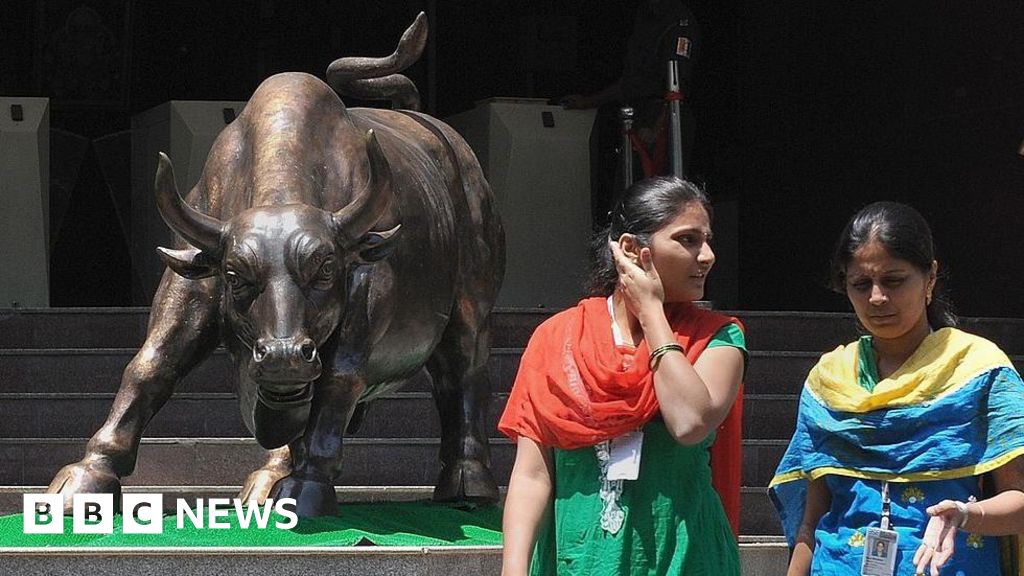
India’s record-setting fundraising spree is raising thorny questions
Nikhil InamdarBBC News, Mumbai
 Getty Images
Getty ImagesIndia’s IPO bull run is being driven partly by mom-and-pop investors India’s ravenous appetite for stock market investing has sparked a fundraising gold rush in Asia’s third largest economy, with its booming initial public offerings (IPO) market undeterred by trade tariffs or global uncertainties.
Major companies – from global co-working firm WeWork India and South Korean conglomerate LG Electronics’ India arm to financial services giant Tata Capital – have raised record-setting amounts of money just this week, offering their shares to investors through IPOs.
Unlike the secondary markets, where investors buy and sell existing stocks of companies, IPOs are used by privately held firms to sell their shares to investors for the first time, and debut on the public markets.
Some 79 companies raked in $11.5bn (£8.58bn) in the first nine months of 2025, while a string of other issues in the final three months of the year is expected to bring in another $10-11bn, pushing India’s IPO market to more than $20bn this year, according to investment bank Kotak Mahindra Capital Company. And this is not counting the fundraising done by India’s small and medium-sized enterprises.
Companies operating in a wide range of sectors including new-age tech firms, e-commerce majors, retail, infrastructure and healthcare players are tapping the IPO market.
“This has given Indian investors the breadth [of investment opportunities] that’s not seen in other countries,” V Jayasankar, managing director at Kotak Mahindra Capital Company, told the BBC.
“Apart from institutional money, systematic investment plans [or fixed monthly contributions] by mom-and-pop investors in mutual funds has kept flows into IPOs robust,” Mr Jayasankar said.
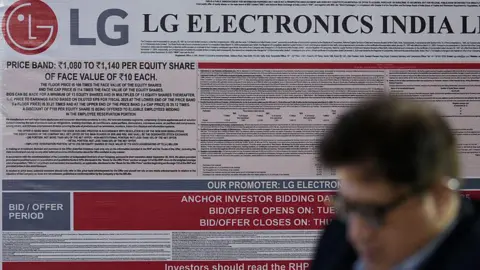 Getty Images
Getty ImagesMajor companies such as LG Electronics India raised money through IPOs this week Besides high demand for new investment opportunities, the market is on fire also because India’s growth over the past decade has birthed a strong pipeline of companies across diverse industries that have reached a certain scale and maturity, according to Abhinav Bharti, head of India equity capital markets at US investment banking giant JP Morgan.
“This is just the start of the trend, and we should see India to be a regular $20bn IPO market on an ongoing basis, if not higher,” Mr Bharti said on the company’s YouTube channel.
But while this wave of new share offerings signals a maturing of India’s investing landscape, the euphoria also demands caution, experts say.
“There’s a lot of exuberance. Investors need to be selective and study the financials of the companies they choose. They must not invest blindly,” says Kranthi Bathini of WealthMills Securities.
The IPO frenzy has hit a fever pitch even as Indian stock markets overall have delivered lacklustre returns to investors.
India’s benchmark Nifty-50 index of its largest and most liquid companies has clocked barely 6% this year, while returns from indices tracking small and mid-sized firms are negative.
Besides concerns about worsening global geopolitics and US President Donald Trump’s 50% tariffs on India, expensive share valuations have worried analysts.
But ironically, this could be contributing to the high interest in debuting companies.
“Investors currently see IPOs as a better place to make returns because of the chance of a 15-20% pop in the stock price on listing,” said Mr Jayasankar.
However estimates suggest that half of the IPOs that have debuted this year are trading below their listing price. Kotak’s own analysis shows that only 43 of the 79 companies that listed this year have given positive returns.
Mr Jayasankar says this could partly be because they were mis-priced (sold expensive) or because the overall market sentiment is low.
Also, the majority of the companies hitting the markets in the first nine months were smaller firms, which tend to be more volatile.
“The last quarter of the year tends to be skewed towards larger or better-quality companies hitting the market,” Mr Jayasankar said.
 Getty Images
Getty ImagesMillions of young Indians are putting money into the markets using online apps While Indians have been lapping up new issues, there has been a distinct lack of interest in these IPOs from foreign investors, who’ve sold over $20bn in Indian equities this year.
“Global investors are in wait-and-watch mode,” said Mr Bathini. “India has gone from being the most favoured nation to the least favoured nation for them in a matter of months, because of tariffs and other uncertainties.”
Their lack of participation in the IPO market reflects an overall reduction in portfolio funds to India, he said.
This, if anything, is an obvious signal that domestic mom-and-pop investors are getting swayed by euphoria rather than fundamentals.
“There is an entire industry working to first build and then maintain this mood,” writes economics commentator Vivek Kaul in a piece for Mumbai Mirror newspaper. This includes investment bankers, analysts at stock brokerages and fund managers, he says.
The frenzy is fun, says Mr Kaul, and a game of perceptions and hype, but “not for turning a modest investment into lasting financial security”.
But Indian investors do not appear to be in a mood to listen.
With companies such as Walmart-backed PhonePe, India’s largest mobile telecoms giant Jio and unicorns [tech start-ups valued at over $1bn] such as Groww and Meesho hitting the markets in the coming months, India’s IPO party is likely to continue, at least for some more time.
Follow BBC News India on Instagram, YouTube, X and Facebook.
Continue Reading
-

Musk settles former Twitter executives’ suit over severance
Elon Musk has agreed to settle a $128m (£100m) lawsuit brought by four former top executives at Twitter, now X, over unpaid severance when he took over the company.
The executives, who include former chief Parag Agrawal, argued that Mr Musk fired them “without reason” after he bought Twitter in 2022 and denied them severance payments.
“The parties have reached a settlement and the settlement requires certain conditions to be met in the near term,” attorneys for the plaintiffs wrote in a court filing last week. They did not disclose the terms of the settlement.
The suit, filed last year, is one of several legal challenges over unpaid severance for workers who were laid off after Musk took over.
Lawyers for the former Twitter executives, and for Mr Musk and X, did not immediately respond to requests for comment on the settlement.
The former top brass – Mr Agrawal, former chief financial officer Ned Segal, former chief legal officer Vijaya Gadde and former general counsel Sean Edgett – contended in their lawsuit that they are owed one year’s salary and stock awards, under a years-old severance plan.
They also said Musk’s move was part of a pattern of refusing to pay former staff what they were due.
In August, Mr Musk and X agreed to settle a separate lawsuit filed by roughly 6,000 former rank-and-file Twitter employees who argued they were owed $500m in severance pay.
Mr Musk purchased Twitter in 2022 for $44bn, after initially trying to back out of his offer. After the acquisition closed, he immediately moved to fire top leaders at the company, including the four executives. Mr Musk slashed Twitter’s workforce by more than half.
In their lawsuit, the former top officials contend that Mr Musk was frustrated about being forced to complete the purchase and that the billionaire falsely accused them of misconduct to push them out.
Continue Reading
-

Red Light, green light – Transfer pricing issues for intercompany loans | Tax Alert – October 2025
By Young Jin Kim & Bart de Gouw
It is widely accepted that cross-border related-party debt can be used by multinational enterprises (MNEs) to shift profits out of a country. In the New Zealand context this led to the introduction of the Restricted Transfer Pricing (RTP) rules and the requirement to disclose inbound cross-border intercompany loans with a value of more than NZD10M to Inland Revenue in the BEPS Disclosure Form (this disclosure requirement has since been amended effective from the 2025 income year with taxpayers just required to hold a copy of the necessary information).
In recent years, the International Revenue Strategy (IRS) team at Inland Revenue has observed considerable behavioural change by foreign-owned MNEs with the introduction of additional equity and/or reducing related-party debt financing. This behavioural change has been attributed to the introduction of the RTP rules and a greater focus on financing by the Inland Revenue (via targeted campaigns, risk reviews and audits).
The past five years has seen a highly volatile interest rate environment, with historic lows in the Official Cash Rate in the 2020 and 2021 years, a rapid increase in 2022 and 2023, and a declining rate since the middle of 2024. This level of volatility has meant that taxpayers should have been regularly reviewing intercompany financing arrangements to ensure that the behaviour of the parties to the loans, the terms and conditions of loans, and the interest rate have all remained arm’s length. With the increases in the interest rates applying to the most recently filed 2023 and 2024 tax returns coupled with the Inland Revenue stepping up its audit activity more generally, we are expecting intercompany loans and financing to become a key area of focus for Inland Revenue. This is starting to come to fruition with the number of risk reviews and audits focusing on intercompany financing increasing.
Risk assessment – Are you a green light or red light?
Now is an opportune time for taxpayers to reflect on their intercompany loans and key risk areas that could be challenged by Inland Revenue. To help with this, we have summarised 9 risk factors when it comes to intercompany loans.
- The loan is over NZD10m at any time during the income year. RTP rules will apply to the loan and an analysis of the rules will be necessary, which can lead to material denial of interest deductibility as the borrowers’ credit rating may be adjusted and certain loan terms and conditions disregarded.
- No documented loan terms. Loan agreements are important – this will be the starting point for any Inland Revenue review. In the absence of a valid agreement, Inland Revenue may seek to imply (unfavourable) terms and any pricing analysis conducted to support the interest rate will not have strong basis.
- Loan agreements that do not clearly state what the arrangement is and what the key purpose of the funds advanced is.
- The arrangement is non-commercial or contains ‘exotic’ features such as subordination, interest deferral of more than 12 months, or has a term of more than five years. Under the RTP rules, certain exotic terms cannot be priced into the interest rate.
- Using a fixed interest rate for a revolving credit facility loan (that can be drawn down and repaid by the borrower) or a floating interest rate for a fixed term loan (the reset of an interest rate on a fixed term loan is likely a trigger point requiring a retesting the application of the RTP rules).
- The loan has been extended, renegotiated, or renewed in the past year. This could make a big difference to the deductible level of interest as the interest rate environments change very quickly and these events also require retesting of the application of the RTP rules.
- Has the loan been reset at a higher interest rate? Is this what a third-party borrower would do, i.e. is the behaviour of the parties demonstrably arm’s length?
- Does the borrower have a high debt percentage? Greater than 40% is considered high risk for borrowers with a cross border related party borrowing of more than NZD10m. Similarly, borrowing from related parties in low tax jurisdictions (<15% tax rate) is also a risk factor as set out in the RTP rules.
- Be mindful of interest gross up clauses – any additional interest paid under a gross-up clause also needs to be arm’s length.
Update to Inland Revenue’s administrative guidance on small value loans
Inland Revenue annually publishes an administrative guidance for small value loans (i.e., for cross-border associated party loans for up to NZD10M principal). This administrative guidance may be applied to cross-border associated party loans.
Inland Revenue has historically provided an interest rate margin (over a relevant base indicator) that it considers to be broadly indicative of an arm’s length rate, in the absence of a readily available market rate for a debt instrument with similar terms and risk characteristics. The most recent change to the interest margin has also introduced (without explanation or consultation) a change in approach to make the interest rate margin backward looking only and in our view, reduces the practical application of this otherwise widely used administrative guidance. The current interest rate margin in the guidance is 250 basis points over the relevant base rate and applies for the period 1 July 2024 to 30 June 2025. There is now no equivalent guidance for interest rates for the year to 30 June 2026. We will continue to provide updates on any developments on the administrative guidance.
Next steps
If any of the above risk factors concern you please contact your usual Deloitte advisor or one of our award winning transfer pricing team to help navigate the issues.
Continue Reading
-

Millions left behind: The push to simplify unclaimed money claims | Tax Alert – October 2025
By Amy Sexton & Robyn Walker
The prospect of a significant sum of money lying dormant and unclaimed will motivate many to search the Inland Revenue’s unclaimed money database, especially when media coverage draws attention to its existence. The recent Taxation (Annual Rates for 2025–26, Compliance Simplification, and Remedial Measures) Bill (the Bill) proposes changes aimed at simplifying the management of unclaimed money by Inland Revenue, with the intention of making it easier for rightful owners to make claims.
What is ‘unclaimed money’
Unclaimed money are funds held by an individual or organisation (such as bank, solicitor, utility company, life insurer, employer, other business) where the rightful owner cannot be located. After a specified period of time passes without contact, these funds are classified as “unclaimed” and transferred to an administrator. The required time period varies depending on the type of funds involved.
While Inland Revenue is widely recognised for administering unclaimed money, not all categories of unclaimed funds fall under its responsibility, a raft of options are outlined on The Treasury website.
What are the proposed changes?
Additional information
Currently the Unclaimed Money Act 1971 puts the following obligations on holders of unclaimed money:
- A holder must make reasonable efforts to locate the owner of money that is, or will soon become, unclaimed money and to communicate with the owner concerning the money.
- A holder of money that pays the money to the Commissioner as unclaimed money must provide to the Commissioner, with or before the payment and in a form acceptable to the Commissioner, the information relating to the owner and the money that is in the possession or control of the holder and is readily available to the holder, including—
a. the source, and history of the accrual, of the amount
b. the identity and whereabouts of the owner
c. the source of the owner’s entitlement to payment of the money.
Under the Bill. when transferring unclaimed money, holders will be required to provide Inland Revenue with more detailed information to assist in identifying the rightful owner. The new legislation will read as follows:
- A holder must make reasonable efforts to locate the owner of money that is, or will soon become, unclaimed money and to communicate with the owner concerning the money.
- A holder of money that pays the money to the Commissioner as unclaimed money must provide to the Commissioner, with or before the payment and in a form acceptable to the Commissioner, the information relating to the owner and the money that is in the possession or control of the holder and is readily available to the holder, including—
a. the source, and history of the accrual, of the amount
i. the full name, date of birth, and tax file number of the owner
ii. the address and contact details of the owner
b. the whereabouts of the owner
c. the source of the owner’s entitlement to payment of the money
d. where applicable, the number of the account where the money is held, the date the account was opened, and the date of the owner’s last interaction with the account.
It is important to note that under both the current and proposed legislation, the information needs to be in the “possession or control” and “readily available” to the holder. With more data points being required upfront there will be a need for businesses dealing with unclaimed money to give thought to whether new systems and processes are required to efficiently extract information, particularly if it is spread across different information sources.
20 year time bar
In 2021 a 25 year time bar was introduced for unclaimed money administered by Inland Revenue. The proposal is to reduce this time bar to 20 years (which is still a very long time!). If money remains unclaimed after the time bar, it will be removed from the unclaimed money list and transferred to the Crown.
Why make changes?
Currently, claimants often face challenges in proving ownership of unclaimed money, leading to considerable correspondence with Inland Revenue. These proposed changes are intended to streamline the process for all parties involved. For context, in the 2023/24 year Inland Revenue received 23,000 claims for unclaimed money but approved only 4,300 claims, amounting to $36.5m, with over $0.5b remaining unclaimed.
These proposed changes are scheduled to take effect from 1 April 2026.
If you believe you may have a claim to unclaimed money and are unsure how to establish ownership, please contact your usual Deloitte advisor for assistance.
Continue Reading
-
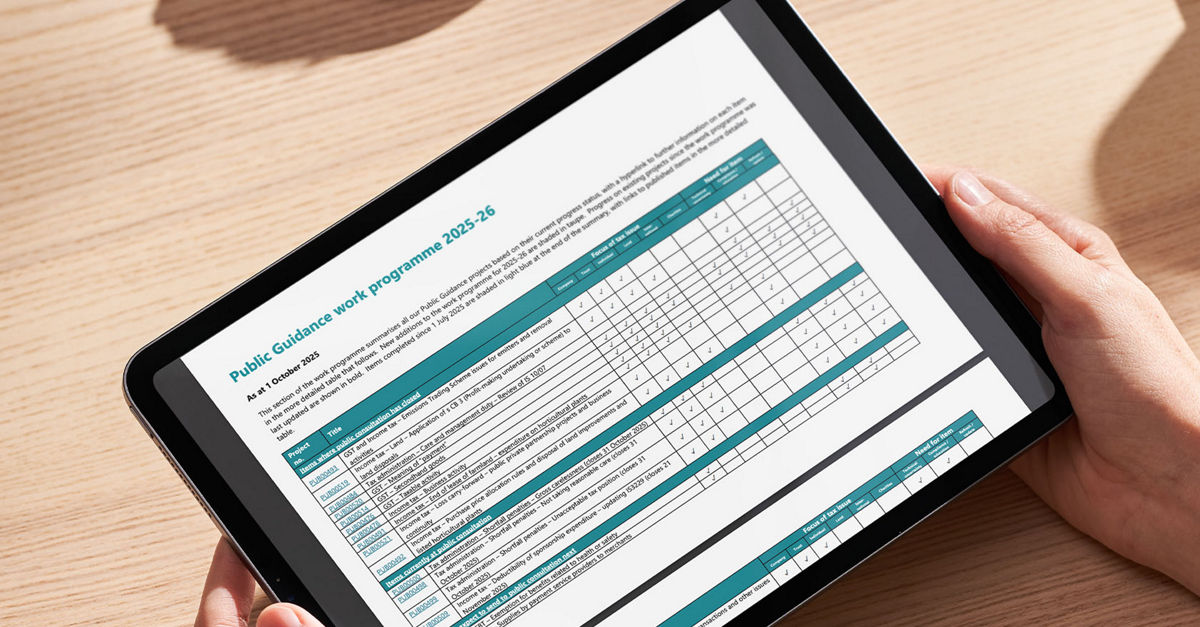
Published, pending, and on hold: Inland Revenue’s public guidance work programme | Tax Alert – October 2025
By Joe Sothcott & Robyn Walker
The Public Guidance Work Programme is a frequently overlooked yet invaluable publication produced by the Inland Revenue’s Tax Counsel Office. The Tax Counsel Office (TCO) is responsible for determining the Commissioner of Inland Revenue’s view on the tax laws and provides advice on tax technical matters, as well has having some oversight as to how tax laws are implemented within in the Inland Revenue.
The Work Programme tracks the status of priority interpretation items under development. With the latest update published on 1 October 2025 we take a look at what’s currently included, what’s missing, how it’s compiled, and what new items have been added.
What Is the Public Guidance Work Programme?
The Work Programme currently includes only items issued by the TCO, specifically:
- Interpretation statements – These set out the Commissioner’s view on how tax law applies to broader areas of tax. (Items finalised in year to September 2025: 22)
- Questions we’ve been asked (QWBAs) – Short-form guidance responding to specific, practical questions raised by taxpayers or advisors. (Items finalised in year to September 2025: 20)
While both are non-binding, they are considered authoritative and are widely relied upon by taxpayers and advisors.
The Work Programme does not include items produced by the Technical Standards team, such as:
- Standard practice statements (Items finalised in year to September 2025: 0)
- Operational statements (Items finalised in year to September 2025: 5)
- Commissioner’s statements (Items finalised in year to September 2025: 0)
- Kilometre rates for motor vehicle expenses (annually published)
- Determinations (Items finalised in year to September 2025: 17)
For example, the Draft Standard Practice Statement on Mutual Transactions of Associations (ED0265) is not listed in the Work Programme. Deloitte understands that, after public consultation over the draft guidance, the item is now on hold pending referral to Inland Revenue’s Policy team for a potential policy change.
Deloitte’s view is that all public guidance items, whether from the TCO Office or the Technical Standards team, should be published in a single consolidated work programme. This would improve transparency and make it easier to identify when items are on hold pending policy consideration.
How Is the Work Programme compiled?
The Work Programme includes:
- Consultation items—including those scheduled to begin consultation, currently under consultation, or where consultation has recently closed.
- Pre-consultation items in development or not yet started
- Items currently on hold
Transparency is the underlying principle of the Public Guidance Work Programme. TCO refreshes the Work Programme annually, and prior to each refresh, it invites public submissions on technical issues, gaps in existing guidance, and emerging areas of uncertainty. Submissions generally can be made via email or via an Inland Revenue form. Keep an eye out around mid-2026 for the next opportunity to contribute submissions for the Work Programme.
Once submissions are received, the TCO evaluates them based on:
- Importance of the issue
- Level of uncertainty or ambiguity
- Number of taxpayers affected
- Need to resolve existing issues
- Potential revenue implications
A draft Work Programme is then prepared and circulated to key stakeholders for feedback (including on relative priority) before the final version is published.
What’s new in the 2025–26 Work Programme?
The refreshed Work Programme includes a long list of new items:
- PUB00523: Income tax and GST – associated persons
- PUB00524: GST – B2B loyalty schemes
- PUB00525: GST – Compulsory zero-rating of land – update of IS 17/08
- PUB00526: GST – Concurrent land use
- PUB00527: GST – Financial services – custodian, supervisor and trustee fees
- PUB00528: GST – Financial services – planning fees – refresh of IS0052
- PUB00529: GST – Goods and services acquired for $10,000 or less
- PUB00530: GST – Types of unincorporated bodies
- PUB00531: Income tax – B2B loyalty schemes
- PUB00532: Income tax – deductions – financial planning fees – refresh of IS0044
- PUB00533: Income tax – Depreciation – low value assets
- PUB00534: Income tax – Intra-group dividends – s CD 27
- PUB00535: Income tax – Losses – business continuity and part year losses
- PUB00536: Income tax – NZ custodians’ ‘top-up’ amount of RWT
- PUB00537: Income tax – Retention money and performance bonds under construction contracts – update of QB 13/04
- PUB00538: Income tax – Schedular payments – withholding obligations under Sch 4, Part F
- PUB00539: Income tax – Share lending issues
- PUB00540: Income tax – Transferable development rights
- PUB00541: Income tax – Trusts – interest deductibility
- PUB00543: Income Ttax – FIFs – whether cost and CV methods can be used concurrently
- PUB00544: Income tax – When is a trustee a bare trustee
- PUB00545: GST – Fees of board members appointed by the Governor-General or Governor-General in Council
Some taxpayers may understandably have trepidations about a few of the items and whether they may open a pandora’s box where interpretation doesn’t match reality, in light of the open-loop gift cards debate that arose from the publication of QB 25/07: What is the income tax treatment of gift cards and products provided as trade rebates or promotions? Other items, such as guidance on often misunderstood areas, like how taxpayers can apply the 100% depreciation rate for low value assets under section EE 38, will be more welcome.
Want to suggest an Item?
We understand that raising issues for inclusion in the Work Programme can feel daunting—especially if there’s concern it might attract unwanted scrutiny. For those may feel uneasy about contact the TCO direct, Deloitte is always happy to raise issues on behalf of clients. If you have questions or would like to discuss a potential submission, please reach out to your usual Deloitte advisor.
Continue Reading
